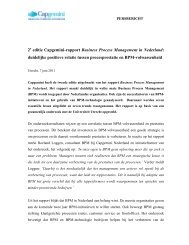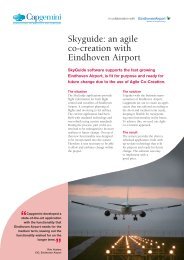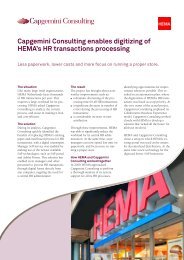IT transformations - Capgemini Consulting Nederland
IT transformations - Capgemini Consulting Nederland
IT transformations - Capgemini Consulting Nederland
You also want an ePaper? Increase the reach of your titles
YUMPU automatically turns print PDFs into web optimized ePapers that Google loves.
Figure 3: Stakeholders in the Cloud Computing Ecosystem<br />
Figure 4: Enterprise Cloud Offerings of Select Vendors<br />
Examples<br />
Cloud Enablers<br />
■ Provide the technology,<br />
infrastructure, platforms, and<br />
middleware to enable the<br />
provision of cloud services<br />
Source: <strong>Capgemini</strong> TME Strategy Lab Analysis<br />
Oracle on Demand<br />
Cisco Webex<br />
Salesforce CRM<br />
IBM Lotus Live<br />
Salesforce Force.com<br />
Google App Engine<br />
Microsoft Azure<br />
Amazon Web Services<br />
BT<br />
Orange Business Services<br />
AT&T<br />
GoGrid<br />
Rackspace<br />
EMC MozyEnterprise<br />
Nirvanix CloudNAS<br />
Software (SaaS)<br />
Cloud Service<br />
Vendors (CSVs)<br />
■ Provide the actual cloud<br />
services, spanning SaaS,<br />
PaaS and IaaS, to customers<br />
Application<br />
Development<br />
Platform (PaaS)<br />
Source: <strong>Capgemini</strong> TME Strategy Lab Analysis; Company Websites<br />
Service Providers<br />
■ Provide cloud focused<br />
business consulting, and<br />
technology services such as<br />
system integration, cloud<br />
migration, and maintenance<br />
Infrastructure as a Service (IaaS)<br />
Servers<br />
Storage<br />
Several companies are competing<br />
aggressively to grab the largest share<br />
of the lucrative cloud computing<br />
market. These players fall largely<br />
under one of these three categories:<br />
enablers, vendors, or service providers<br />
(see Figure 3). The role of some<br />
mature players, however, can also<br />
span a number of categories. For<br />
instance, both Cisco and IBM are<br />
cloud enablers as well as CSVs 12 .<br />
Leading technology vendors such<br />
as Amazon, Salesforce.com and<br />
Microsoft have established a firm<br />
footing in this market and offer a<br />
range of services spanning SaaS, PaaS,<br />
and IaaS (see Figure 4). In terms of<br />
revenues, the current CSV landscape<br />
is dominated by players such as<br />
Salesforce.com, Amazon, and Oracle.<br />
Salesforce.com, the leading provider<br />
of SaaS CRM 13 solutions, reported<br />
revenues of over US$1billion 14 in<br />
2009, which is the highest amongst<br />
CSVs. The success of these leaders<br />
can be attributed to their technical<br />
prowess, early mover advantage, and<br />
the strong focus on cloud computing.<br />
Though large technology players<br />
have emerged as leaders in cloud<br />
computing, several smaller companies<br />
such as Rackspace and Netsuite are<br />
trying to carve their niche. Telcos<br />
such as BT and AT&T have also<br />
entered this market. In the next<br />
section, we will evaluate the cloud<br />
computing initiatives and strategies of<br />
telcos.<br />
Telco Activity in Cloud<br />
Computing<br />
Compared to market leaders such as<br />
Amazon and Salesforce.com, telco<br />
entry into cloud computing has been<br />
reasonably late. While Salesforce.<br />
com started offering services in 1999,<br />
BT and T-Systems, one of the earliest<br />
telcos to offer cloud solutions, entered<br />
12 Cloud Service Vendors.<br />
13 Customer Relationship Management.<br />
14 Company Websites; Annual Report.<br />
22
















